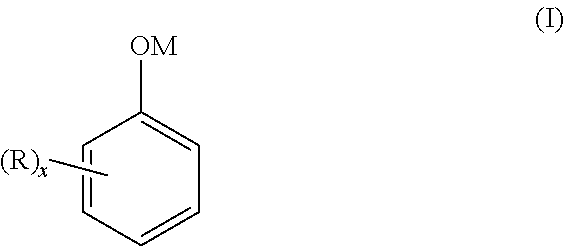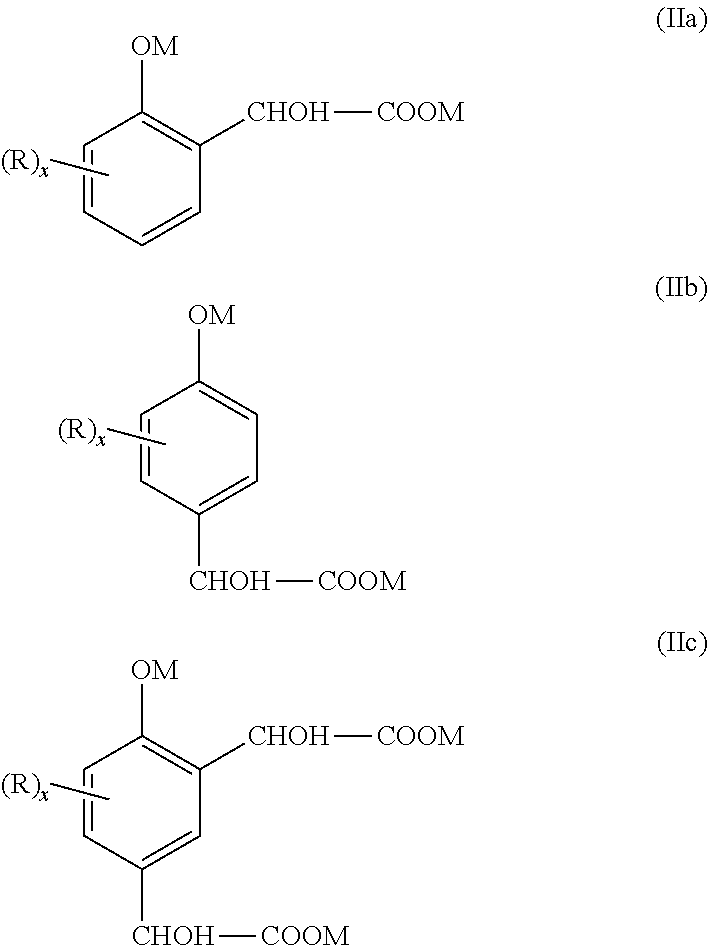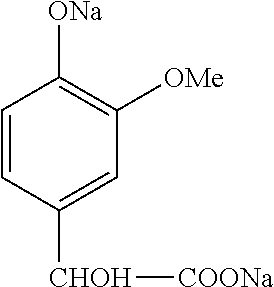Method for separating salified phenolic compounds
a technology of phenolic compounds and salified form, which is applied in the field of separating phenolic compounds in salified form, can solve the problems of substantial salt effluent formation and difficult operation
- Summary
- Abstract
- Description
- Claims
- Application Information
AI Technical Summary
Benefits of technology
Problems solved by technology
Method used
Image
Examples
example 1
[0145]In this example, the adsorbent used is 5A molecular sieve.
[0146]This solid is a calcium aluminosilicate. It possesses a pore diameter of 0.5 nm.
[0147]A Schott tube is charged with 20 g of a stream comprising 0.95 g of sodium guaiacolate (0.0065 mol) and 1.32 g of sodium p-mandelate (0.0055 mol) of formula:
[0148]Then 2 g of 5A molecular sieve are added, and the reaction mixture is stirred at 40° C. throughout the duration of the adsorption.
[0149]The adsorption is monitored by high-performance liquid chromatography analysis of said solution.
[0150]After 15 minutes, 45% of guaiacolate is adsorbed.
[0151]After 1 hour 30 minutes, 55% by weight of guaiacolate is adsorbed (expressed relative to the total weight of guaiacolate present in the solution to be treated), with no attachment of mandelates.
[0152]The ratio defining the selectivity is 1.
example 2
[0153]In this example, a Y zeolite is employed, namely the hydrophobic zeolite Wessalith DAY 55. The pore diameter of this zeolite is 0.72 nm.
[0154]Example 1 is repeated, with the only difference that the nature of the adsorbent is changed.
[0155]With this adsorbent, 44% of guaiacolate is adsorbed after 15 minutes, with no adsorption of mandelates.
[0156]The selectivity obtained is 1.
example 3
[0157]In this example, an adsorbent polymer is employed which is called Amberlite XAD16, which is a copolymer of styrene and divinylbenzene and is a nonionic polymer. It is present in the form of beads, it possesses a large specific surface area of more than 700 m2 / g, and its structure is very porous: the average pore size is 10 nm.
[0158]Example 1 is repeated, with the only difference that the nature of the adsorbent is changed.
[0159]With this adsorbent, the selectivity obtained is 1, and a 60% solution of guaiacolate remains.
PUM
| Property | Measurement | Unit |
|---|---|---|
| molar ratio | aaaaa | aaaaa |
| molar ratio | aaaaa | aaaaa |
| temperature | aaaaa | aaaaa |
Abstract
Description
Claims
Application Information
 Login to View More
Login to View More - R&D
- Intellectual Property
- Life Sciences
- Materials
- Tech Scout
- Unparalleled Data Quality
- Higher Quality Content
- 60% Fewer Hallucinations
Browse by: Latest US Patents, China's latest patents, Technical Efficacy Thesaurus, Application Domain, Technology Topic, Popular Technical Reports.
© 2025 PatSnap. All rights reserved.Legal|Privacy policy|Modern Slavery Act Transparency Statement|Sitemap|About US| Contact US: help@patsnap.com



